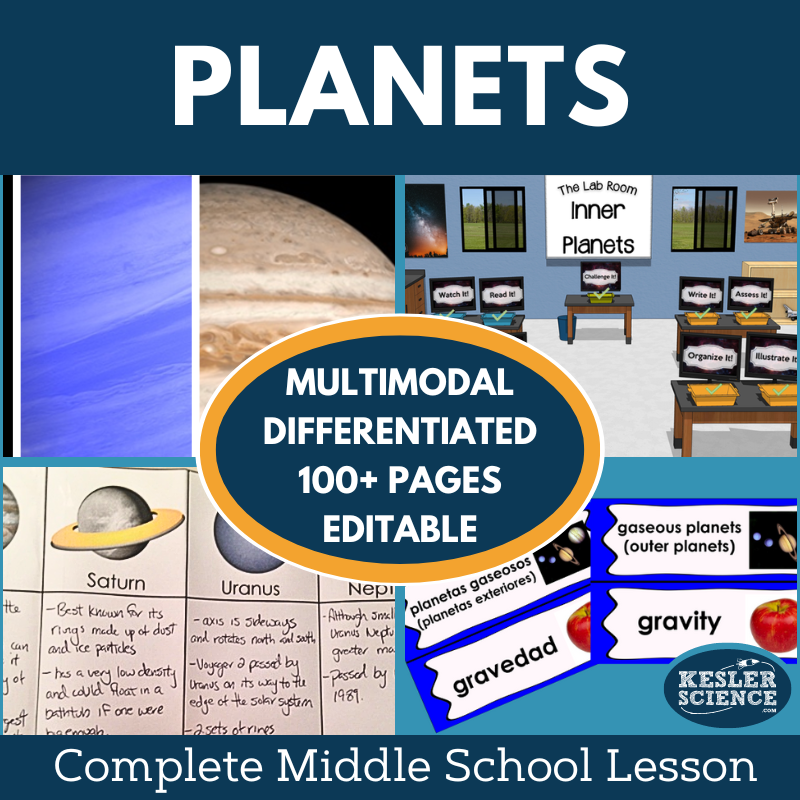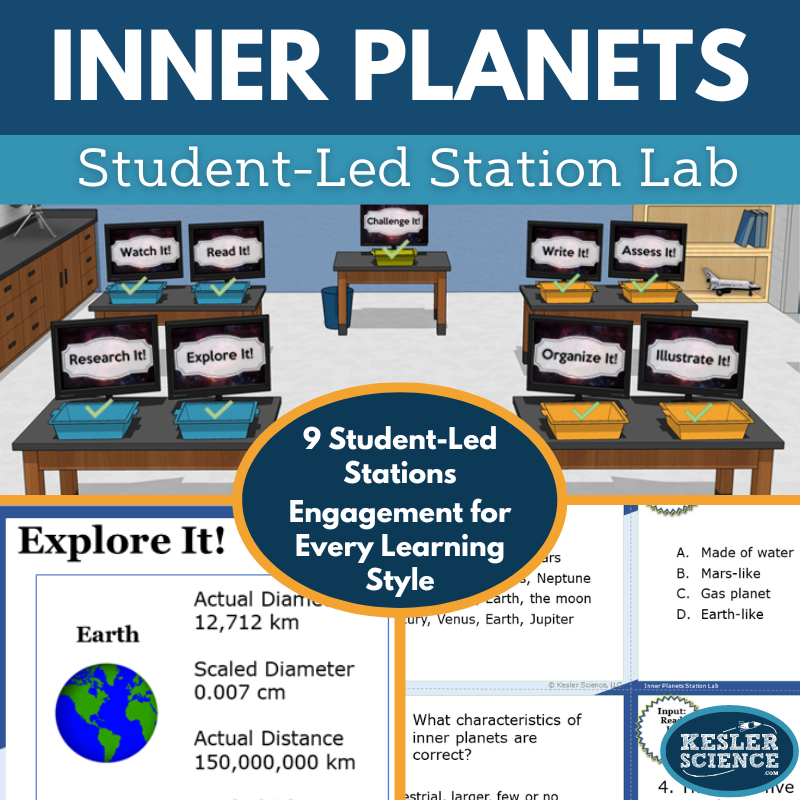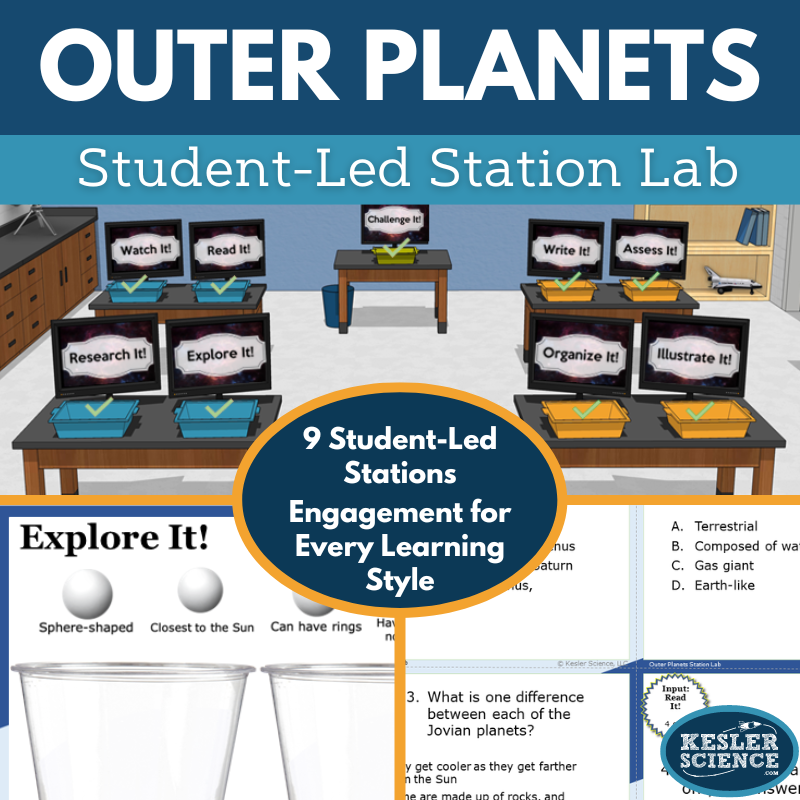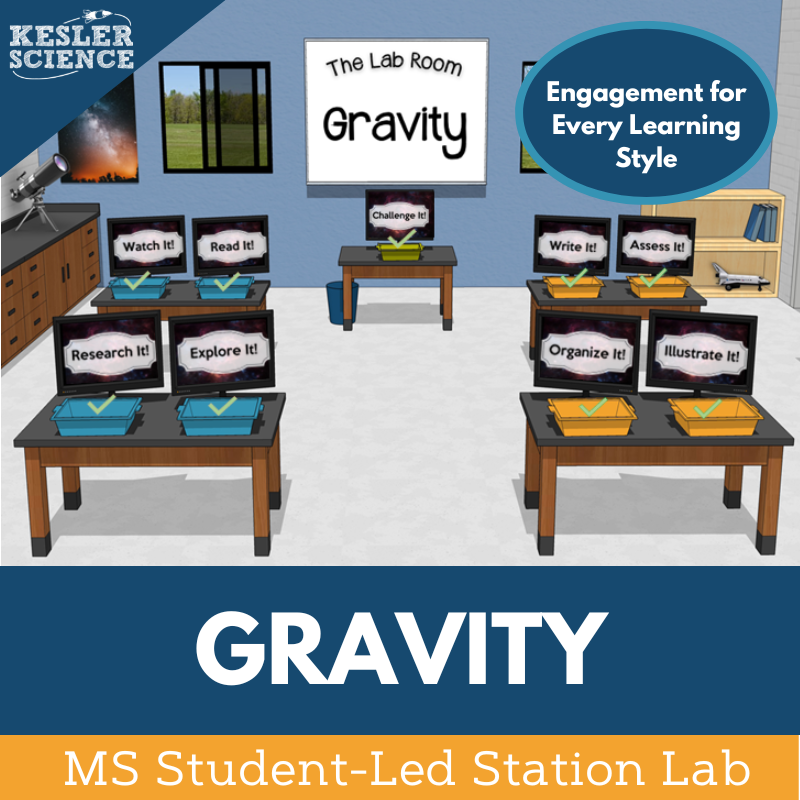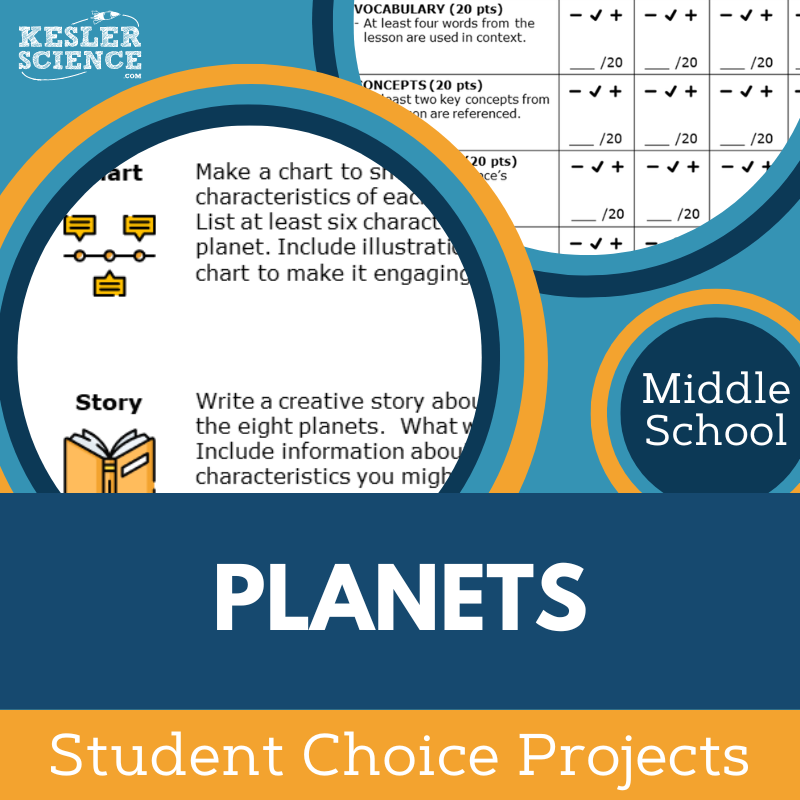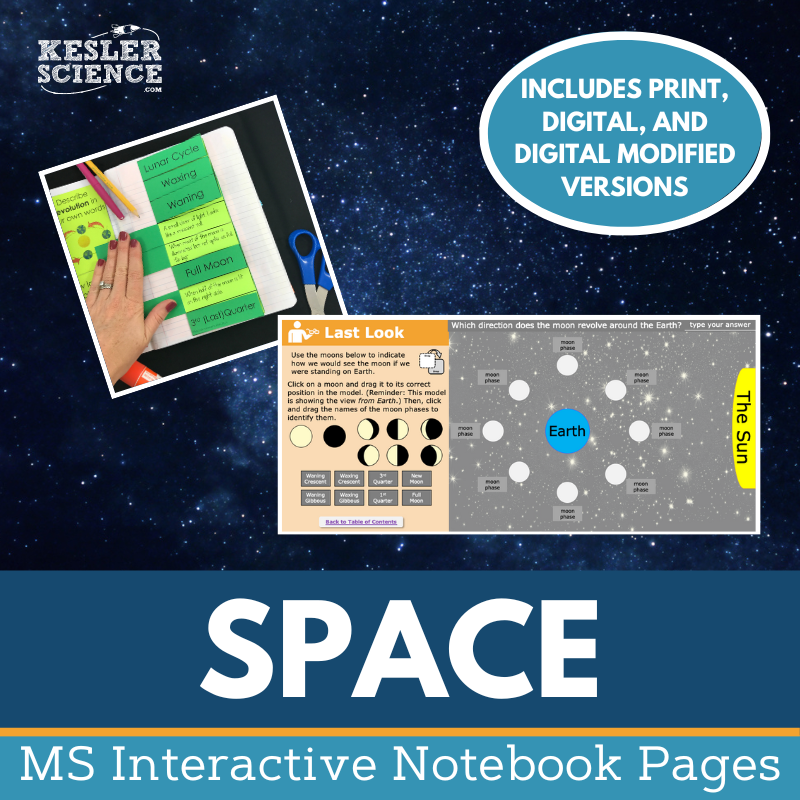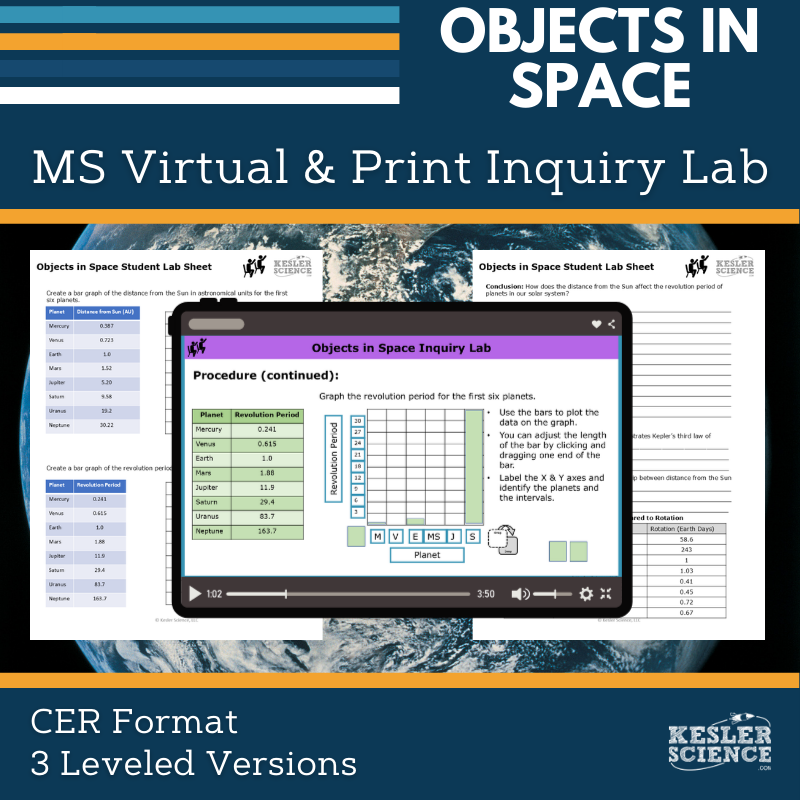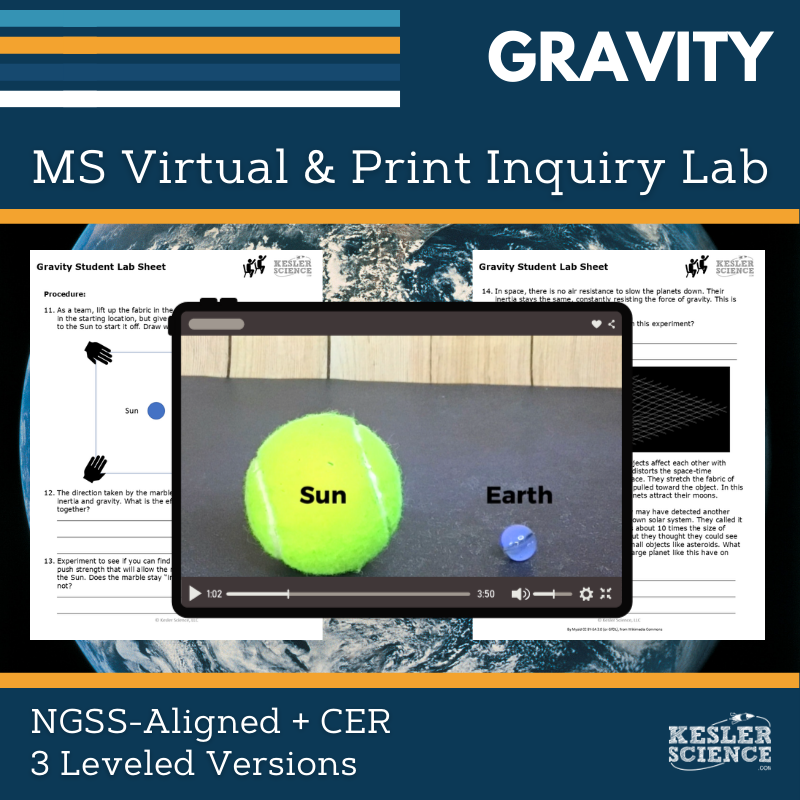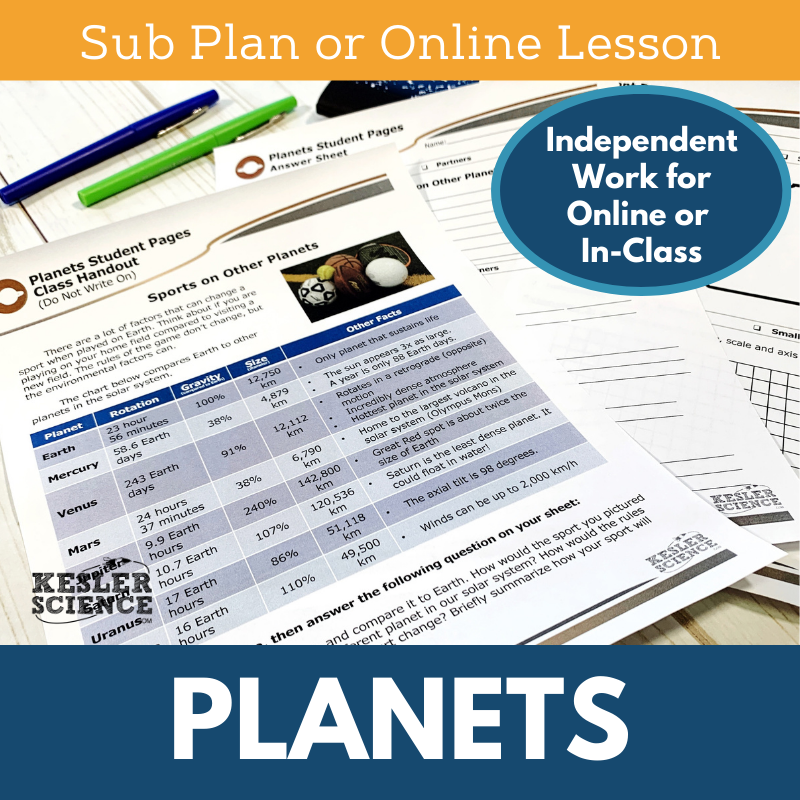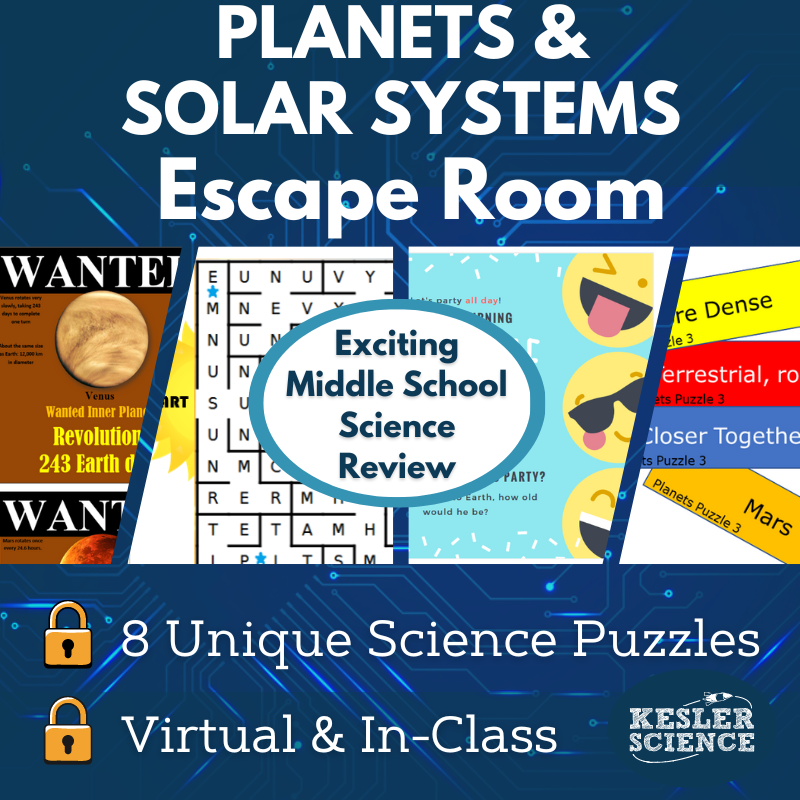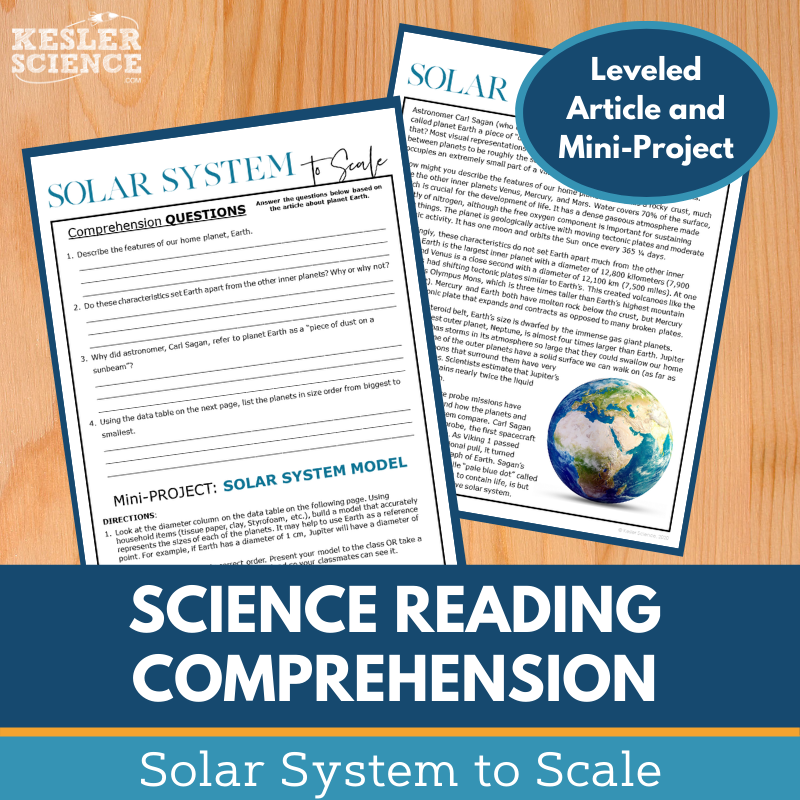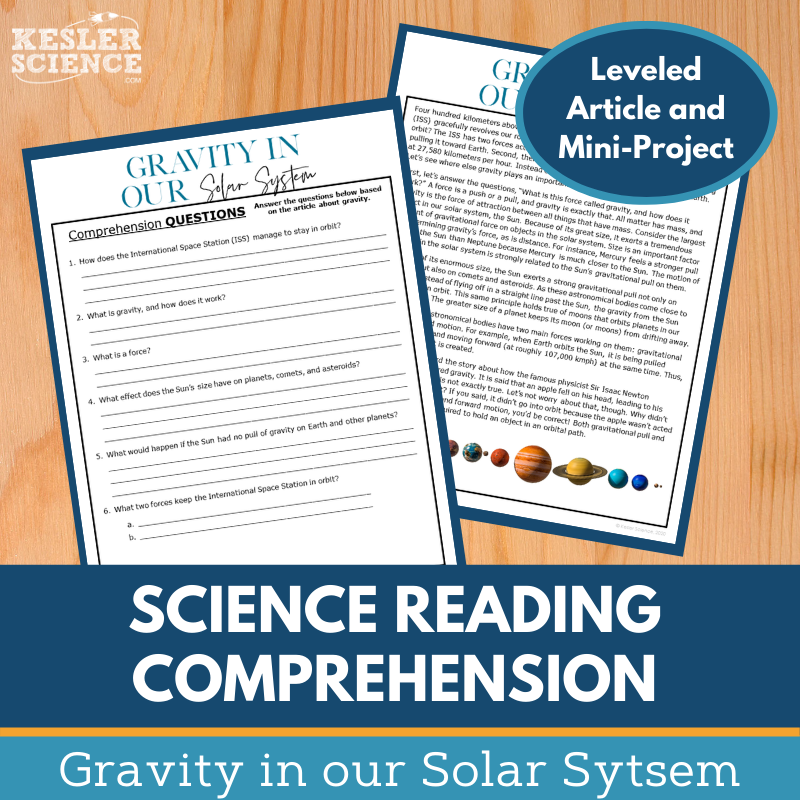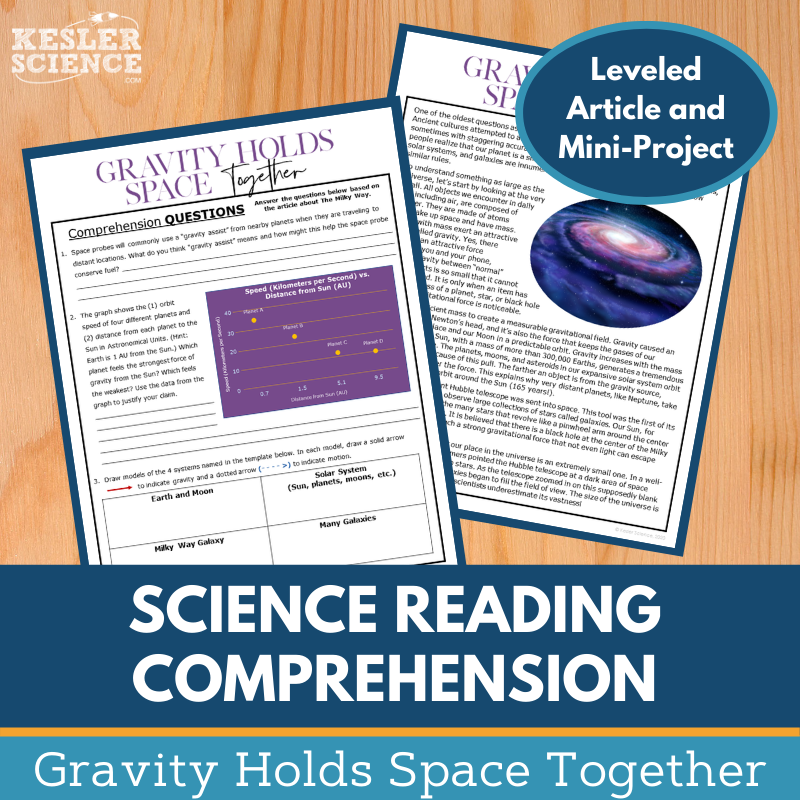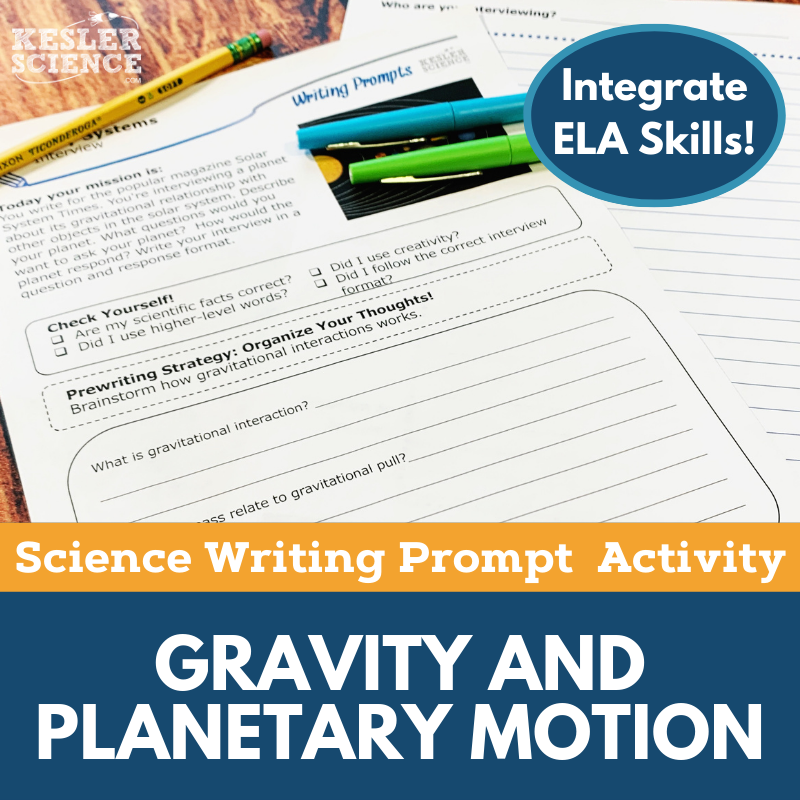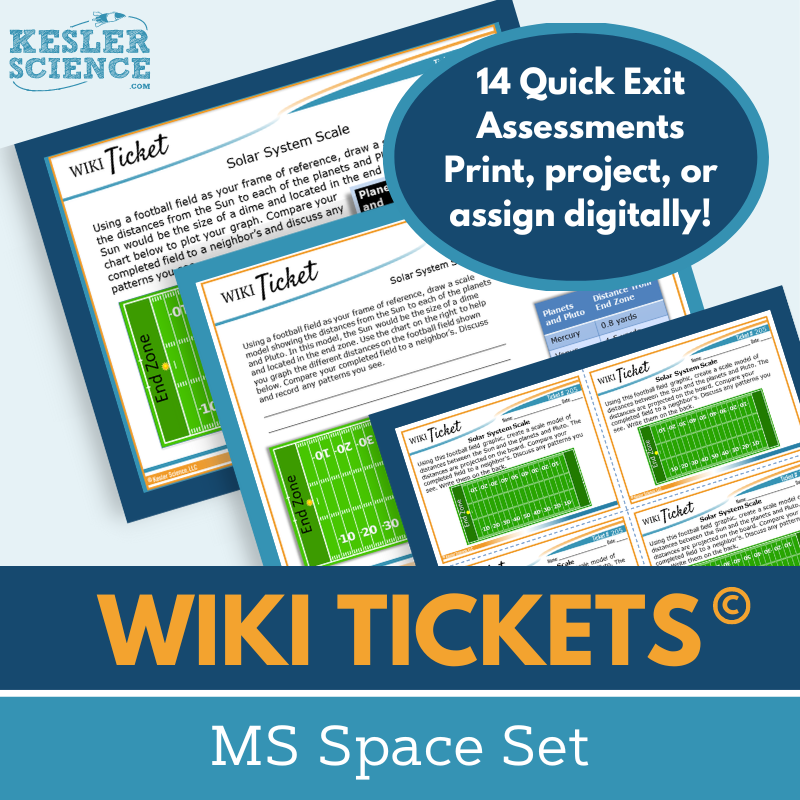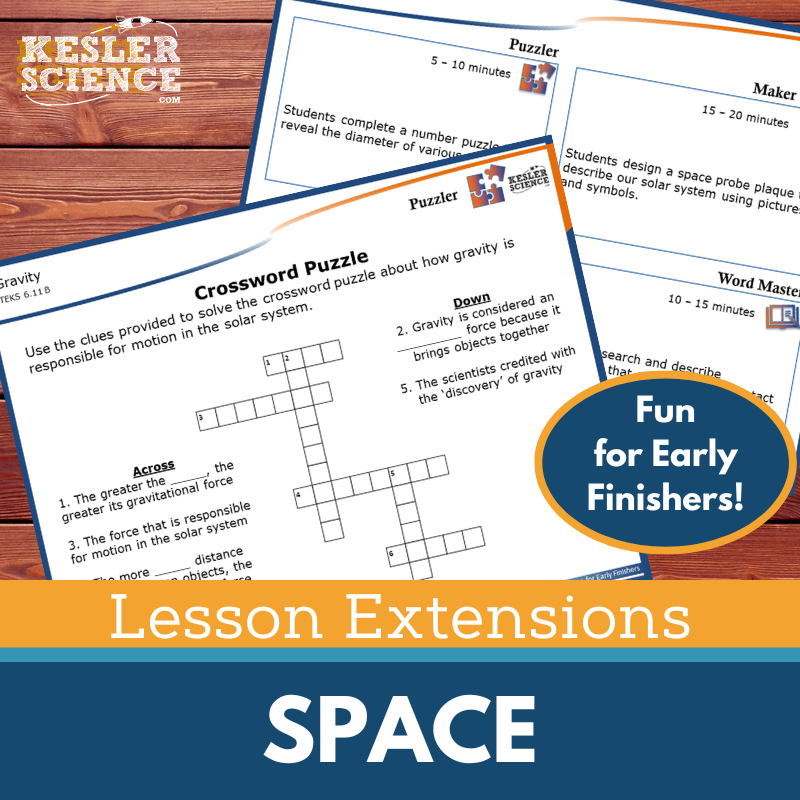Planets and Gravity Activities for Middle School Science
The Kesler Science Planets resources provide an engaging, comprehensive way to explore the solar system with your middle school students. The resources below will give students a comprehensive understanding of planets and gravity. All of the following materials are also included in the Kesler Science Membership.
The Kesler Science Planets Complete 5E Lesson covers the characteristics and movements of the inner and outer planets, providing students with the opportunity to explore essential questions like "Can you describe the physical properties of planets and their location?" and "Can you describe the movements of the Sun, planets, and Galilean moons?" The unit is fully editable and designed for minimal prep, offering differentiated, student-led activities that allow you to focus on student success.
The lesson is based on the 5E Model, with activities in each stage, including engaging objectives, word wall cards, and activities to spark class discussions. The Exploration phase features a student-led station lab with nine differentiated stations, such as hands-on demos ("Explore It!"), reading passages in English and Spanish ("Read It!"), and multimedia learning tools like videos ("Watch It!") and websites ("Research It!"). Output stations encourage students to demonstrate knowledge through categorization ("Organize It!"), drawing ("Illustrate It!"), writing ("Write It!"), and more.
The Kesler Science Planets Complete 5E Lesson covers the characteristics and movements of the inner and outer planets, providing students with the opportunity to explore essential questions like "Can you describe the physical properties of planets and their location?" and "Can you describe the movements of the Sun, planets, and Galilean moons?" The unit is fully editable and designed for minimal prep, offering differentiated, student-led activities that allow you to focus on student success.
The lesson is based on the 5E Model, with activities in each stage, including engaging objectives, word wall cards, and activities to spark class discussions. The Exploration phase features a student-led station lab with nine differentiated stations, such as hands-on demos ("Explore It!"), reading passages in English and Spanish ("Read It!"), and multimedia learning tools like videos ("Watch It!") and websites ("Research It!"). Output stations encourage students to demonstrate knowledge through categorization ("Organize It!"), drawing ("Illustrate It!"), writing ("Write It!"), and more.
The Kesler Science Inner Planets Station Lab is a modular, student-led activity designed to engage middle school students in exploring how gravity governs the motion of the solar system. With eight differentiated stations and a ninth challenge station for advanced learners or early finishers, this resource fosters independent and collaborative learning while saving teachers valuable prep time.
Students encounter planetary science concepts through input stations like "Explore It!" for hands-on activities, "Read It!" with differentiated passages in English and Spanish, "Research It!" for online exploration, and "Watch It!" for engaging videos. Output stations, including "Organize It!", "Illustrate It!", "Write It!", and "Assess It!", provide varied ways for students to demonstrate understanding, with creative and structured activities tailored to their needs.
This versatile resource includes all necessary signage, task cards, and materials for in-person and virtual learning environments. Digital options ensure students can work independently on platforms like Google Slides, making the Planets Station Lab an ideal choice for personalized and flexible instruction.
The Kesler Science Inner Planets Station Lab is a modular, student-led activity designed to engage middle school students in exploring how gravity governs the motion of the solar system. With eight differentiated stations and a ninth challenge station for advanced learners or early finishers, this resource fosters independent and collaborative learning while saving teachers valuable prep time.
Students encounter planetary science concepts through input stations like "Explore It!" for hands-on activities, "Read It!" with differentiated passages in English and Spanish, "Research It!" for online exploration, and "Watch It!" for engaging videos. Output stations, including "Organize It!", "Illustrate It!", "Write It!", and "Assess It!", provide varied ways for students to demonstrate understanding, with creative and structured activities tailored to their needs.
This versatile resource includes all necessary signage, task cards, and materials for in-person and virtual learning environments. Digital options ensure students can work independently on platforms like Google Slides, making the Planets Station Lab an ideal choice for personalized and flexible instruction.
The Kesler Science Outer Planets Station Lab is a modular, student-led activity designed to engage middle school students in understanding that gravity governs the motion of our solar system. With minimal prep, this resource allows students to direct their own learning while teachers guide and facilitate. The station lab features eight differentiated activities and a ninth challenge station for advanced learners or early finishers.
The lab includes input and output stations, offering diverse ways to engage with and demonstrate learning. Input stations—like "Explore It!", "Research It!", "Read It!", and "Watch It!"—introduce planetary science through hands-on demonstrations, research tasks, readings, and videos. Output stations, such as "Organize It!", "Illustrate It!", "Write It!", and "Assess It!", allow students to show their knowledge through creative and structured methods. All stations include signage, resources, and task cards for independent or group work.
This resource is adaptable for in-person and virtual learning, with printable and digital options for flexibility. Differentiated passages, Spanish translations, and interactive components ensure accessibility for all students. Whether using physical manipulatives or digital tools, the Planets Station Lab promotes personalized and meaningful engagement with space science concepts.
The Kesler Science Outer Planets Station Lab is a modular, student-led activity designed to engage middle school students in understanding that gravity governs the motion of our solar system. With minimal prep, this resource allows students to direct their own learning while teachers guide and facilitate. The station lab features eight differentiated activities and a ninth challenge station for advanced learners or early finishers.
The lab includes input and outputstations, offering diverse ways to engage with and demonstrate learning. Input stations—like "Explore It!", "Research It!", "Read It!", and "Watch It!"—introduce planetary science through hands-on demonstrations, research tasks, readings, and videos. Output stations, such as "Organize It!", "Illustrate It!", "Write It!", and "Assess It!", allow students to show their knowledge through creative and structured methods. All stations include signage, resources, and task cards for independent or group work.
This resource is adaptable for in-person and virtual learning, with printable and digital options for flexibility. Differentiated passages, Spanish translations, and interactive components ensure accessibility for all students. Whether using physical manipulatives or digital tools, the Planets Station Lab promotes personalized and meaningful engagement with space science concepts.
Engage your classroom with this student-led station lab all about gravity, designed to support middle school students as they explore the role of gravity in the motions of galaxies and the solar system. Perfect for in-person or virtual learning, the lesson features nine modular stations that include hands-on tasks, videos, readings, and digital activities. These comprehensive materials allow students to take charge of their learning while saving teachers valuable prep time.
Each station offers a unique, differentiated activity that caters to various learning styles, with an optional challenge station for early finishers. Input stations provide engaging ways to build knowledge, including reading passages (available in English and Spanish), videos, web-based research, and interactive demonstrations. Output stations allow students to demonstrate understanding through drawing, writing, organizing information, and completing assessments using vocabulary in context.
All resources are compatible with PowerPoint and Google Slides, making them ideal for flexible classroom environments. Whether students are sketching gravitational models, watching short educational videos, or completing extension challenges, this lab encourages active participation and critical thinking.
Engage your classroom with this student-led station lab all about gravity, designed to support middle school students as they explore the role of gravity in the motions of galaxies and the solar system. Perfect for in-person or virtual learning, the lesson features nine modular stations that include hands-on tasks, videos, readings, and digital activities. These comprehensive materials allow students to take charge of their learning while saving teachers valuable prep time.
Each station offers a unique, differentiated activity that caters to various learning styles, with an optional challenge station for early finishers. Input stations provide engaging ways to build knowledge, including reading passages (available in English and Spanish), videos, web-based research, and interactive demonstrations. Output stations allow students to demonstrate understanding through drawing, writing, organizing information, and completing assessments using vocabulary in context.
All resources are compatible with PowerPoint and Google Slides, making them ideal for flexible classroom environments. Whether students are sketching gravitational models, watching short educational videos, or completing extension challenges, this lab encourages active participation and critical thinking.
The Kesler Science Planets Student Choice Projects inspire middle school students to showcase their understanding of planetary science in a way that aligns with their learning style. With six distinct project options and a “design your own” choice, students have the flexibility to engage creatively while demonstrating their knowledge. A detailed grading rubric supports assessments by teachers, peers, or the students themselves, fostering accountability and self-reflection.
This resource is designed with flexibility in mind, featuring editable rubrics and differentiated project pages to accommodate diverse learner needs. Three modified project options offer extra support for students needing remediation, while advanced learners can tackle a combination of projects. The multimodal approach ensures personalized and engaging learning experiences for all students.
With minimal supplies required, such as paper, markers, and scissors, the projects are classroom-friendly and adaptable for digital completion. Whether using basic materials or crafting tools for building models, students can explore planetary science creatively and meaningfully.
The Kesler Science Planets Student Choice Projects inspire middle school students to showcase their understanding of planetary science in a way that aligns with their learning style. With six distinct project options and a “design your own” choice, students have the flexibility to engage creatively while demonstrating their knowledge. A detailed grading rubric supports assessments by teachers, peers, or the students themselves, fostering accountability and self-reflection.
This resource is designed with flexibility in mind, featuring editable rubrics and differentiated project pages to accommodate diverse learner needs. Three modified project options offer extra support for students needing remediation, while advanced learners can tackle a combination of projects. The multimodal approach ensures personalized and engaging learning experiences for all students.
With minimal supplies required, such as paper, markers, and scissors, the projects are classroom-friendly and adaptable for digital completion. Whether using basic materials or crafting tools for building models, students can explore planetary science creatively and meaningfully.
The Kesler Science Space Science Interactive Notebook is an engaging resource for teachers looking to create interactive learning experiences for their students. It includes both print and digital versions, making it perfect for traditional classrooms, 1:1 environments, or distance learning.
The bundle covers key space science topics such as asteroids, meteors, and comets, the Big Bang theory, eclipses, the electromagnetic spectrum, galaxies, and more. The digital version features a PowerPoint interactive notebook, which can be uploaded to Google Slides or learning management systems like MS Teams or Canvas. Reflection pages and space for students to take notes are included, along with a teacher answer key and modified versions for students with accommodations.
The print version provides a full set of blank templates for students, pre-filled templates for those needing modifications, and color photos to illustrate how each template should be used. This bundle is designed to support differentiated learning and keep students engaged in key space science concepts.
The Kesler Science Space Science Interactive Notebook is an engaging resource for teachers looking to create interactive learning experiences for their students. It includes both print and digital versions, making it perfect for traditional classrooms, 1:1 environments, or distance learning.
The bundle covers key space science topics such as asteroids, meteors, and comets, the Big Bang theory, eclipses, the electromagnetic spectrum, galaxies, and more. The digital version features a PowerPoint interactive notebook, which can be uploaded to Google Slides or learning management systems like MS Teams or Canvas. Reflection pages and space for students to take notes are included, along with a teacher answer key and modified versions for students with accommodations.
The print version provides a full set of blank templates for students, pre-filled templates for those needing modifications, and color photos to illustrate how each template should be used. This bundle is designed to support differentiated learning and keep students engaged in key space science concepts.
The Objects in Space Inquiry Lab aligns with the NGSS standard and engages students in exploring how the distance of a planet from the Sun affects its period of revolution. Through four distinct lab options, students analyze orbital distances and revolutionary periods, with one lab even taking place outside for hands-on measurements. After data analysis, students apply their understanding by making predictions about other planets in the solar system.
This resource includes three differentiated versions—dependent, modified, and independent—to support diverse learning needs. Each version is available in both print and digital formats, making it flexible for classroom or remote learning. Comprehension questions, C.E.R. prompts, and a reflection section are built into every version to encourage deeper thinking and science communication skills.
Printable labs require simple materials like yarn and colored pencils, while the digital version needs no materials and offers interactive experiences within a PowerPoint file. Editable files, teacher directions, answer keys, and compatibility with Google Slides ensure the lab is easy to implement and adapt to any classroom setting.
The Objects in Space Inquiry Lab aligns with the NGSS standard and engages students in exploring how the distance of a planet from the Sun affects its period of revolution. Through four distinct lab options, students analyze orbital distances and revolutionary periods, with one lab even taking place outside for hands-on measurements. After data analysis, students apply their understanding by making predictions about other planets in the solar system.
This resource includes three differentiated versions—dependent, modified, and independent—to support diverse learning needs. Each version is available in both print and digital formats, making it flexible for classroom or remote learning. Comprehension questions, C.E.R. prompts, and a reflection section are built into every version to encourage deeper thinking and science communication skills.
Printable labs require simple materials like yarn and colored pencils, while the digital version needs no materials and offers interactive experiences within a PowerPoint file. Editable files, teacher directions, answer keys, and compatibility with Google Slides ensure the lab is easy to implement and adapt to any classroom setting.
The Gravity Inquiry Lab aligns with NGSS MS-ESS1-2, guiding students to model the forces of inertia and gravity that keep planets in orbit. In both print and digital versions, students explore how gravitational forces shape planetary motion and consider the effects of a large, hypothetical planet on the solar system. This flexible lab includes a hands-on activity with marbles, balls, and fabric or an interactive digital experience with a guided video demonstration—no materials needed for the virtual version.
Each version of the lab is differentiated at three levels: Dependent, Modified, and Independent. The Dependent lab balances guidance and inquiry for on-level students, while the Modified lab offers structured support for students who need more scaffolding. The Independent version encourages advanced learners to take full ownership of their investigations, with minimal guidance and extended application of concepts using an Internet-connected device.
Editable files in PowerPoint and Google Slides formats allow teachers to customize content. Additional support includes answer keys, CER prompts, reflection questions, and detailed teacher resource pages outlining standards, objectives, and prep time. Whether used in person or online, this lab promotes multimodal, student-centered learning with maximum flexibility.
The Gravity Inquiry Lab aligns with NGSS MS-ESS1-2, guiding students to model the forces of inertia and gravity that keep planets in orbit. In both print and digital versions, students explore how gravitational forces shape planetary motion and consider the effects of a large, hypothetical planet on the solar system. This flexible lab includes a hands-on activity with marbles, balls, and fabric or an interactive digital experience with a guided video demonstration—no materials needed for the virtual version.
Each version of the lab is differentiated at three levels: Dependent, Modified, and Independent. The Dependent lab balances guidance and inquiry for on-level students, while the Modified lab offers structured support for students who need more scaffolding. The Independent version encourages advanced learners to take full ownership of their investigations, with minimal guidance and extended application of concepts using an Internet-connected device.
Editable files in PowerPoint and Google Slides formats allow teachers to customize content. Additional support includes answer keys, CER prompts, reflection questions, and detailed teacher resource pages outlining standards, objectives, and prep time. Whether used in person or online, this lab promotes multimodal, student-centered learning with maximum flexibility.
The Kesler Science Planets Sub Plans provide a complete, student-centered plan for both in-class and distance learning. Students engage with a warm-up activity, read a data table about planet characteristics, and complete activities to explore topics such as gravity and orbits. Extension activities, like creating a graph or designing a t-shirt, help early finishers stay engaged.
For substitutes, the lesson includes comprehensive instructions, a letter to the sub, and behavior checkpoints. The lesson also features a summative assessment or exit ticket to wrap up the activities. Digital options are available with a Google Form answer sheet and a student PDF for use in Google Classroom or for annotation in PDF editors like Kami.
The lesson is versatile, making it ideal for substitutes, ISS, homework, or small group use. It’s also perfectly suited for remote learning, with all necessary materials provided for digital access.
The Kesler Science Planets Sub Plans provide a complete, student-centered plan for both in-class and distance learning. Students engage with a warm-up activity, read a data table about planet characteristics, and complete activities to explore topics such as gravity and orbits. Extension activities, like creating a graph or designing a t-shirt, help early finishers stay engaged.
For substitutes, the lesson includes comprehensive instructions, a letter to the sub, and behavior checkpoints. The lesson also features a summative assessment or exit ticket to wrap up the activities. Digital options are available with a Google Form answer sheet and a student PDF for use in Google Classroom or for annotation in PDF editors like Kami.
The lesson is versatile, making it ideal for substitutes, ISS, homework, or small group use. It’s also perfectly suited for remote learning, with all necessary materials provided for digital access.
The Kesler Science Planets Escape Room is an immersive, student-centered activity where middle school students showcase their knowledge of inner and outer planets through engaging puzzles. Teachers have full control, choosing from eight independent challenges to customize the experience for any class period. This flexibility ensures a tailored, time-efficient learning adventure for students.
This escape room can be implemented using simple materials like manila envelopes or enhanced with locks and a storage box for a more authentic experience. Digital options include a single-student PowerPoint version or printable PDF, both designed for easy integration with Google Slides or learning management systems. These versatile formats support in-person and remote learning setups.
The resource includes teacher directions, editable answer keys, digital answer sheets, and printable props for all puzzles. With extras like video challenges, reward templates, and over 50 prize ideas, the Planets Escape Room ensures an engaging, memorable activity that reinforces key science concepts while building problem-solving skills.
The Kesler Science Planets Escape Room is an immersive, student-centered activity where middle school students showcase their knowledge of inner and outer planets through engaging puzzles. Teachers have full control, choosing from eight independent challenges to customize the experience for any class period. This flexibility ensures a tailored, time-efficient learning adventure for students.
This escape room can be implemented using simple materials like manila envelopes or enhanced with locks and a storage box for a more authentic experience. Digital options include a single-student PowerPoint version or printable PDF, both designed for easy integration with Google Slides or learning management systems. These versatile formats support in-person and remote learning setups.
The resource includes teacher directions, editable answer keys, digital answer sheets, and printable props for all puzzles. With extras like video challenges, reward templates, and over 50 prize ideas, the Planets Escape Room ensures an engaging, memorable activity that reinforces key science concepts while building problem-solving skills.
In the Kesler Science Solar System to Scale reading comprehension activity, students explore the scale of the solar system by reading a nonfiction article detailing the physical and chemical characteristics of Earth and other planets. Accompanied by comprehension questions and a hands-on mini-project, this resource supports middle school science literacy and fosters critical thinking. Leveled reading passages (Lexile 1100-1300) and colorful graphics make the material accessible for grades 6–8, with extensions for advanced 5th graders.
The reading comprehension activity includes 5–7 questions per passage, a Cornell notes template, and an interactive model-building project. It’s versatile enough for whole-class instruction, absent students, extra credit, or science sub plans. Teachers can use it to encourage routine textual analysis, enhance unit-specific learning, or generate engaging classroom discussions.
Optimized for virtual and distance learning, this resource integrates seamlessly with platforms like Google Classroom, MS Teams, and Canvas. Editable files allow students to respond digitally, making it ideal for remote settings or in-person instruction. Students gain critical science comprehension skills while connecting reading to hands-on learning.
In the Kesler Science Solar System to Scale reading comprehension activity, students explore the scale of the solar system by reading a nonfiction article detailing the physical and chemical characteristics of Earth and other planets. Accompanied by comprehension questions and a hands-on mini-project, this resource supports middle school science literacy and fosters critical thinking. Leveled reading passages (Lexile 1100-1300) and colorful graphics make the material accessible for grades 6–8, with extensions for advanced 5th graders.
The reading comprehension activity includes 5–7 questions per passage, a Cornell notes template, and an interactive model-building project. It’s versatile enough for whole-class instruction, absent students, extra credit, or science sub plans. Teachers can use it to encourage routine textual analysis, enhance unit-specific learning, or generate engaging classroom discussions.
Optimized for virtual and distance learning, this resource integrates seamlessly with platforms like Google Classroom, MS Teams, and Canvas. Editable files allow students to respond digitally, making it ideal for remote settings or in-person instruction. Students gain critical science comprehension skills while connecting reading to hands-on learning.
This Gravity in the Solar System Science Reading Comprehension Lesson introduces middle school students to the force that governs the motion of planets through a leveled nonfiction article. After reading, students answer comprehension questions and participate in a hands-on activity by creating and launching a straw rocket to apply what they’ve learned about gravity.
Designed to boost science literacy and reading comprehension, this resource includes two leveled articles (Lexile 1100–1300), a Cornell notes template, and a mini-project. Students engage with five to seven comprehension questions and interact with colorful, printable graphics. The content is suitable for grades 6–8, with support for higher-level 5th graders as well.
This lesson works well in both physical classrooms and virtual environments, with files compatible with platforms like Google Classroom, Schoology, and Canvas. It’s ideal for sub plans, ISS, extra credit, or classroom discussions, and helps students build critical thinking and textual analysis skills while exploring gravity’s role in our solar system.
This Gravity in the Solar System Science Reading Comprehension Lesson introduces middle school students to the force that governs the motion of planets through a leveled nonfiction article. After reading, students answer comprehension questions and participate in a hands-on activity by creating and launching a straw rocket to apply what they’ve learned about gravity.
Designed to boost science literacy and reading comprehension, this resource includes two leveled articles (Lexile 1100–1300), a Cornell notes template, and a mini-project. Students engage with five to seven comprehension questions and interact with colorful, printable graphics. The content is suitable for grades 6–8, with support for higher-level 5th graders as well.
This lesson works well in both physical classrooms and virtual environments, with files compatible with platforms like Google Classroom, Schoology, and Canvas. It’s ideal for sub plans, ISS, extra credit, or classroom discussions, and helps students build critical thinking and textual analysis skills while exploring gravity’s role in our solar system.
In this engaging lesson, students explore the role of gravity in the motion of galaxies and the solar system by reading a nonfiction article about how gravity holds space together. After reading, they answer comprehension questions and create a model of the solar system to deepen their understanding of gravitational forces at work.
The resource includes two leveled reading passages (Lexile levels 1100–1300), typically accompanied by five to seven questions, a hands-on mini-project, and a Cornell notes template. The materials are designed to support reading comprehension and science literacy for grades 6–8, with engaging visuals that can be printed in color or grayscale.
Ideal for virtual or in-person learning, the passage files are compatible with Google Classroom, MS Teams, Schoology, and Canvas. Students can complete work digitally or on paper, making this resource useful for sub plans, ISS, extra credit, or whole-class instruction. The lesson fosters classroom discussion and promotes critical thinking and textual analysis.
In this engaging lesson, students explore the role of gravity in the motion of galaxies and the solar system by reading a nonfiction article about how gravity holds space together. After reading, they answer comprehension questions and create a model of the solar system to deepen their understanding of gravitational forces at work.
The resource includes two leveled reading passages (Lexile levels 1100–1300), typically accompanied by five to seven questions, a hands-on mini-project, and a Cornell notes template. The materials are designed to support reading comprehension and science literacy for grades 6–8, with engaging visuals that can be printed in color or grayscale.
Ideal for virtual or in-person learning, the passage files are compatible with Google Classroom, MS Teams, Schoology, and Canvas. Students can complete work digitally or on paper, making this resource useful for sub plans, ISS, extra credit, or whole-class instruction. The lesson fosters classroom discussion and promotes critical thinking and textual analysis.
The Kesler Science Gravity and Planetary Motion Science Writing Prompt Activity engages middle school students with a creative skit or drama format to explore key earth science concepts. This low-prep, student-centered activity promotes science reasoning and writing skills, making it perfect for elaboration or review alongside other Kesler Science products. Designed for in-person and virtual learning, it keeps students engaged with interactive and flexible materials.
This resource includes teacher directions with an answer guide, project ideas, rubrics, and both full- and half-sheet handouts for easy integration into interactive notebooks or journals. A digital PowerPoint version, compatible with Google Slides, ensures accessibility for remote learners. Students can use pre-writing strategies, self-check tools, and layout templates to enhance their writing experience.
Ideal for cross-curricular activities, formative assessments, or differentiation exercises, this activity is also a great option for early finishers, extra credit, or TELPAS samples. The Gravity and Planetary Motion Writing Prompt offers an engaging way to enrich science exploration and creative expression.
The Kesler Science Gravity and Planetary Motion Science Writing Prompt Activity engages middle school students with a creative skit or drama format to explore key earth science concepts. This low-prep, student-centered activity promotes science reasoning and writing skills, making it perfect for elaboration or review alongside other Kesler Science products. Designed for in-person and virtual learning, it keeps students engaged with interactive and flexible materials.
This resource includes teacher directions with an answer guide, project ideas, rubrics, and both full- and half-sheet handouts for easy integration into interactive notebooks or journals. A digital PowerPoint version, compatible with Google Slides, ensures accessibility for remote learners. Students can use pre-writing strategies, self-check tools, and layout templates to enhance their writing experience.
Ideal for cross-curricular activities, formative assessments, or differentiation exercises, this activity is also a great option for early finishers, extra credit, or TELPAS samples. The Gravity and Planetary Motion Writing Prompt offers an engaging way to enrich science exploration and creative expression.
The Kesler Science Space WIKI Tickets are engaging formative assessments designed for 6th-8th grade science topics, offering multiple flexible formats to check student understanding. Each topic in the Space Set includes five versions: full-screen display, three handout sizes (full, split, and quarter-page), and a digital interactive option that can be used as an editable PowerPoint or Google Slides file.
These assessments are aligned with NGSS and TEKS middle school science standards, with some topics featuring multiple tickets. Each set also includes a bonus table of contents file to show standard alignment, ensuring a comprehensive understanding of the covered topics.
Perfect for both in-class and remote learning, WIKI Tickets can be used as exit tickets, bellringers, or anytime you need to gauge students' progress. Whether projected on a screen or completed digitally, these colorful and engaging assessments provide valuable insight into student comprehension of key space science topics such as the lunar cycle, solar system properties, and space exploration.
The Kesler Science Space WIKI Tickets are engaging formative assessments designed for 6th-8th grade science topics, offering multiple flexible formats to check student understanding. Each topic in the Space Set includes five versions: full-screen display, three handout sizes (full, split, and quarter-page), and a digital interactive option that can be used as an editable PowerPoint or Google Slides file.
These assessments are aligned with NGSS and TEKS middle school science standards, with some topics featuring multiple tickets. Each set also includes a bonus table of contents file to show standard alignment, ensuring a comprehensive understanding of the covered topics.
Perfect for both in-class and remote learning, WIKI Tickets can be used as exit tickets, bellringers, or anytime you need to gauge students' progress. Whether projected on a screen or completed digitally, these colorful and engaging assessments provide valuable insight into student comprehension of key space science topics such as the lunar cycle, solar system properties, and space exploration.
The Kesler Science Space Lesson Extensions provide engaging activities designed to challenge fast finishers and deepen student learning. These critical thinking tasks are connected to NGSS and TEKS space standards, offering rigorous but fun opportunities to explore topics in greater depth. With activities like puzzles, hands-on maker space tasks, tech connections, and creative word writing, these extensions promote STEAM skills and digital literacy.
The Lesson Extensions are structured to provide flexible support for teachers, with clear directions, answer keys, and both digital and paper versions. These materials help reinforce the lesson’s core concepts while offering ways to engage students during testing or other gaps in the schedule.
Perfect for independent learners, these activities push students to apply their knowledge creatively while connecting it to real-world applications. The extensions cover a variety of space science topics, including gravity, space travel, and the lunar cycle, providing additional challenges that extend the learning experience beyond the standard lesson.
The Lesson Extensions are structured to provide flexible support for teachers, with clear directions, answer keys, and both digital and paper versions. These materials help reinforce the lesson’s core concepts while offering ways to engage students during testing or other gaps in the schedule.
Perfect for independent learners, these activities push students to apply their knowledge creatively while connecting it to real-world applications. The extensions cover a variety of space science topics, including gravity, space travel, and the lunar cycle, providing additional challenges that extend the learning experience beyond the standard lesson.
Year-Round Resources
These year-round activities will increase your students' understanding of many middle school science topics. All of these activities are also included in the Kesler Science Membership.
Visual Data & Graphing
You're not alone if your students struggle with understanding graphs, charts, and tables. It's a skill that takes an enormous amount of practice. This resource will help students build a strong foundation in analyzing data and creating their own data visualizations.
Bell Ringers and Warm-Ups
These middle school science bell ringers are an excellent way to engage your students as soon as they walk into your classroom. This comprehensive FULL YEAR resource includes everything you need to start off each science class with an interesting warm-up activity.
Review Board Games
Each game board has been carefully designed to keep students engaged. There are 10 different action spaces on each board and dozens of question cards. All of the actions are related to science concepts and keep the students motivated throughout the game.
Each game is ready to play. Simply print out the board and the cards and let the students enjoy reviewing nine different units.
Essential Questions
Below are the essential questions associated with the lessons and activities included in this unit. This topic is only one of more than 100 middle school science topics included in the Kesler Science Membership.
-
Can you describe the physical properties of planets and their location?
-
Can you describe the movements of the Sun, the planets and the Galilean moons?
Kesler Science Membership
Imagine never having to search for another middle school science lesson again. The membership gives you access to ALL of the Kesler Science products in one place (Yes, including everything above).
Say goodbye to long hours of lesson prep.

